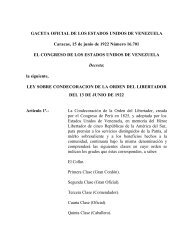Transverse waves on a string - People.fas.harvard.edu
Transverse waves on a string - People.fas.harvard.edu
Transverse waves on a string - People.fas.harvard.edu
Create successful ePaper yourself
Turn your PDF publications into a flip-book with our unique Google optimized e-Paper software.
4.3. IMPEDANCE 13<br />
In the case of uniform tensi<strong>on</strong> discussed in the previous secti<strong>on</strong>, we had T1 = T2, so this<br />
equati<strong>on</strong> r<strong>edu</strong>ced to the first equality in Eq. (24). With the tensi<strong>on</strong>s now distinct, the <strong>on</strong>ly<br />
modificati<strong>on</strong> to the sec<strong>on</strong>d equality in Eq. (24) is the extra factors of T1 and T2. So in terms<br />
of the f functi<strong>on</strong>s, Eq. (34) becomes<br />
− T1<br />
v1<br />
f ′ i (t) + T1<br />
v1<br />
f ′ r(t) = − T2<br />
f ′ t(t). (35)<br />
The other boundary c<strong>on</strong>diti<strong>on</strong> (the c<strong>on</strong>tinuity of the <strong>string</strong>) is unchanged, so all of the<br />
results in the previous secti<strong>on</strong> can be carried over, with the <strong>on</strong>ly modificati<strong>on</strong> being that<br />
wherever we had a v1, we now have v1/T1. And likewise for v2. The quantity v/T can be<br />
written as<br />
where<br />
v<br />
T =<br />
T/µ<br />
T<br />
v2<br />
= 1<br />
√ ≡<br />
T µ 1<br />
, (36)<br />
Z<br />
Z ≡ T<br />
v = T µ (37)<br />
is called the impedance. We’ll discuss Z in depth below, but for now we’ll simply note that<br />
the results in the previous secti<strong>on</strong> are modified by replacing v1 with 1/ √ T1µ1 ≡ 1/Z1, and<br />
likewise for v2. The reflecti<strong>on</strong> and transmissi<strong>on</strong> coefficients in Eq. (31) therefore become<br />
R =<br />
1<br />
Z2<br />
1<br />
Z2<br />
− 1<br />
Z1<br />
+ 1<br />
Z1<br />
= Z1 − Z2<br />
Z1 + Z2<br />
Note that Z grows with both T and µ.<br />
Physical meaning of impedance<br />
and T =<br />
1<br />
Z2<br />
2<br />
Z2<br />
+ 1<br />
Z1<br />
=<br />
2Z1<br />
Z1 + Z2<br />
What is the meaning of the impedance? It makes our formulas look nice, but does it have<br />
any actual physical significance? Indeed it does. C<strong>on</strong>sider the transverse force that the ring<br />
applies to the <strong>string</strong> <strong>on</strong> its left. Since there is zero net force <strong>on</strong> the ring, this force also<br />
equals the transverse force that the right <strong>string</strong> applies to the ring, which is<br />
∂ψR(x, t)<br />
Fy = T2<br />
∂x<br />
<br />
<br />
<br />
<br />
x=0<br />
∂ft(t − x/v2)<br />
= T2<br />
∂x<br />
(38)<br />
<br />
<br />
<br />
, (39)<br />
x=0<br />
where we have labeled the transverse directi<strong>on</strong> as the y directi<strong>on</strong>. But the chain rule tells<br />
us that the x and t partial derivatives of ft are related by<br />
∂ft(t − x/v2)<br />
∂x<br />
= − 1<br />
v2<br />
· ∂ft(t − x/v2)<br />
∂t<br />
. (40)<br />
Substituting this into Eq. (39) and switching back to the ψR(x, t) notati<strong>on</strong> gives<br />
Fy = − T2<br />
·<br />
v2<br />
∂ψR(x,<br />
<br />
t) <br />
<br />
∂t = −<br />
x=0<br />
T2<br />
· vy ≡ −bvy, (41)<br />
v2<br />
where vy = ∂ψR(x, t)/∂t is the transverse velocity of the ring (at x = 0), and where b is<br />
defined to be T2/v2.<br />
This force Fy (which again, is the force that the ring applies to the <strong>string</strong> <strong>on</strong> its left) has<br />
the interesting property that it is proporti<strong>on</strong>al to the (negative of the) transverse velocity.<br />
It therefore acts exactly like a damping force. If we removed the right <strong>string</strong> and replaced<br />
the ring with a massless plate immersed in a fluid (in other words, a pist<strong>on</strong>), and if we

















